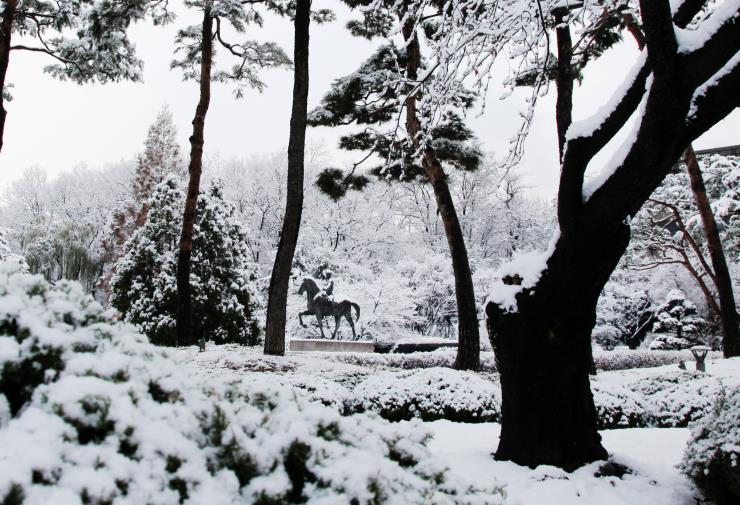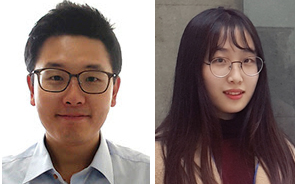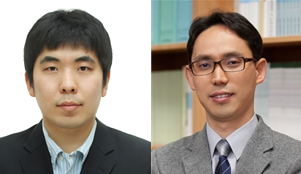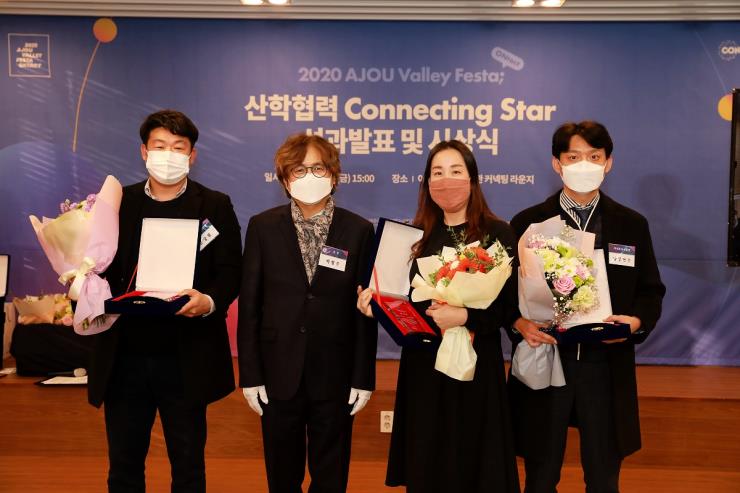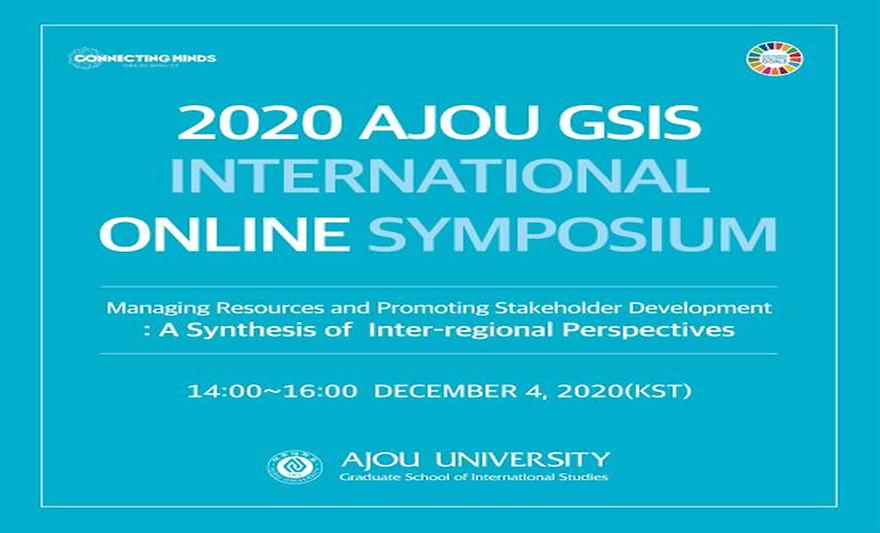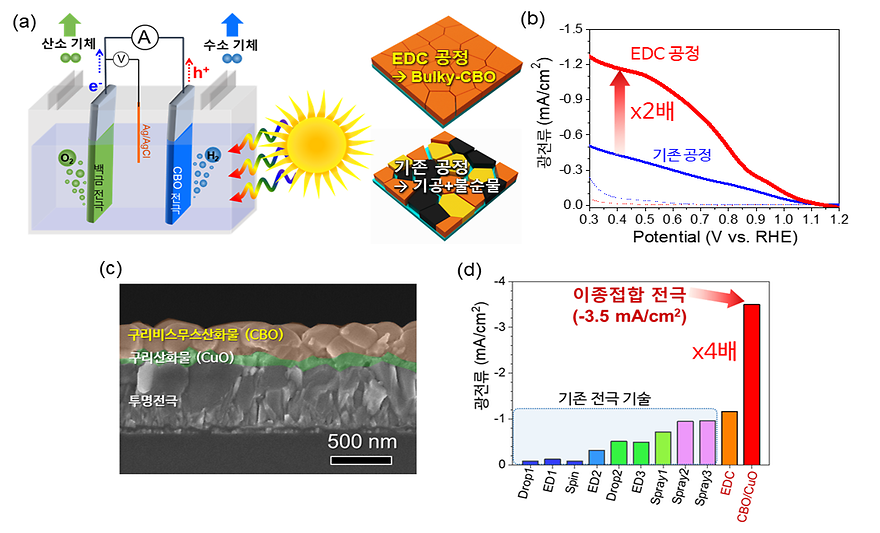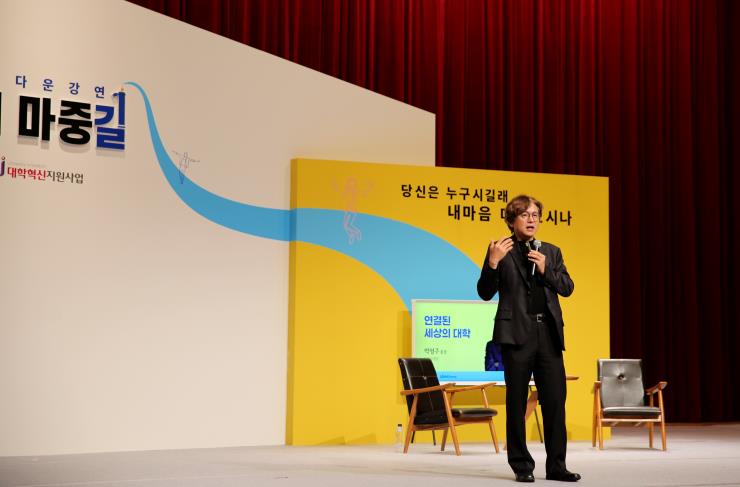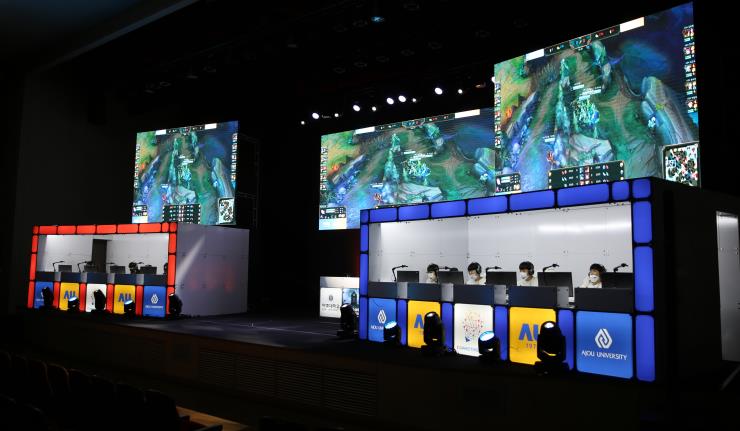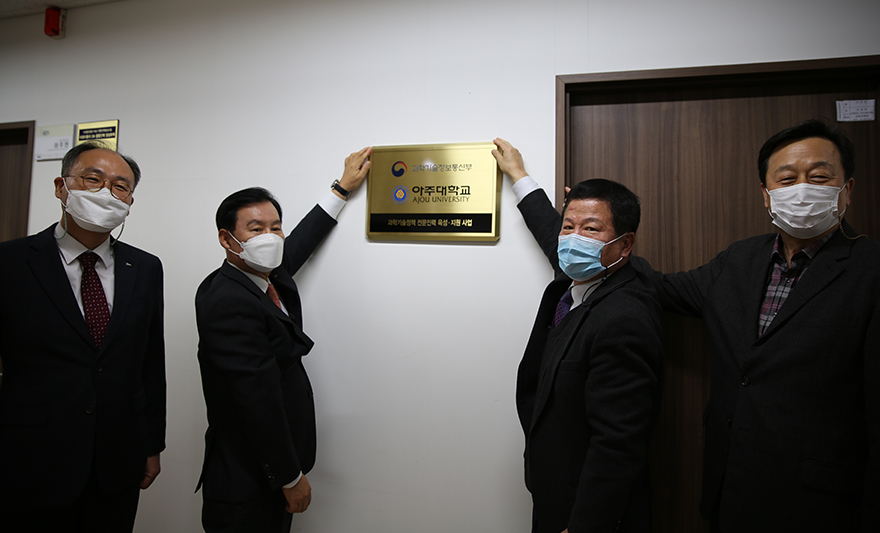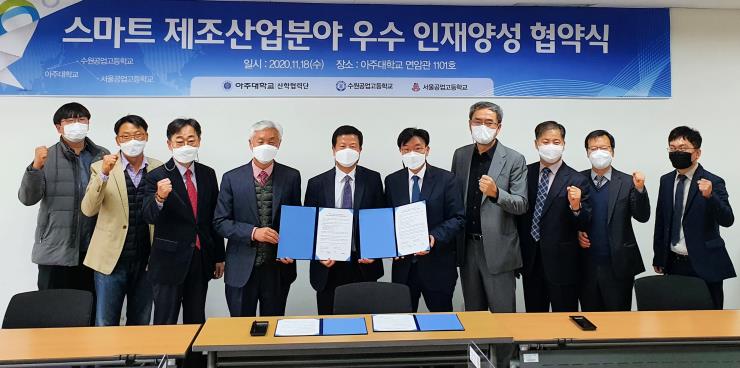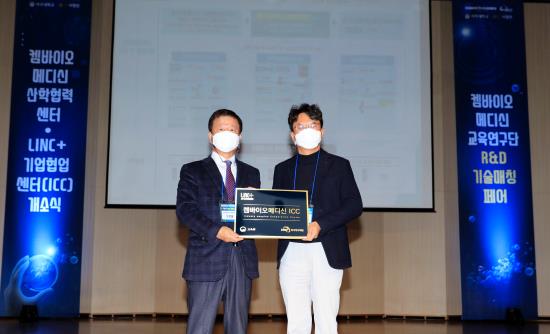-
Ajou University decided to organize its annual ceremony marking the start of the new year online, still determined to share New Year’s greetings and the University’s major accomplishments of the past year and plans for the new year with students notwithstanding the pandemic.The online ceremony featured a New Year’s address from University President Park Hyung-ju; the announcement of Ajou Vision 4.0, a mid- to long-term plan for the University’s development; and discussions of the University’s performance in 2020 and major plans for 2021. The ceremony also shared the top 10 headlines featuring Ajou University from 2020, showing notable achievements and progress that shone light on the school in the midst of COVID-19.Ajou President Park said during his address: “I am grateful for the dedication, hard work, and understanding that members of the Ajou community have shown us this past year.” He added: “Let us embark on this new year with new hopes, new expectations, and new attitudes.”“As a university committed to actively leading innovation in education,” Park explained, “Ajou will continue to develop a new paradigm in education with substantial effects on more disciplines and programs.” He went on: “We will continue with our various initiatives for strengthening the University’s research capabilities as well.”Ajou Vision 4.0, released upon the University’s anniversary in 2019, lays down the University’s goals for intermediate- and long-term growth, defining the trajectories in which education, research, and culture on campus are to evolve.# Watch the University President’s New Year’s address#Watch Ajou Vision 4.0 / Reflection on 2020 / Main Plans for 2021# Watch Top 10 Headlines from Ajou 2020
-
480
- 작성자OI***
- 작성일2021-01-26
- 6179
- 동영상동영상
-
Prof. Shim Tae-soup (left) and Kim Min-a (right)A team of Ajou researchers led by Prof. Shim Tae-soup (Dept. of Chemical Engineering and Dept. of Energy Systems Research) has developed stimulus-responsive hydrogel structures whose surfaces can be controlled at the micrometer level.The team’s work on generating crease patterns using stimulus-responsive hydrogels was entitled, “Stepwise Evolution of Crease Patterns on Stimuli-Responsive Hydrogels for the Production of Long-Range Ordered Structures,” and published as the featured article in the December issue of Advanced Materials Interfaces, an international journal on cutting-edge materials. Kim Min-a, a master’s candidate in the Department of Energy Systems Research, also participated as the first author.Crease-prone soft matter can change form easily when thermal energy is applied. Much applied research has been conducted to utilize its pliable physico-chemical properties and microstructures through application of a variety of external stimuli.Surface creases found on organisms, including fingerprints and palm prints, have especially garnered attention for their potential to increase the surface areas of industrial materials and for their superior fluid and elastic properties. Attempts have been made to simulate these creases in engineering. The mechanisms for forming such creases, however, occur arbitrarily without seeming patterns, frustrating researchers’ repeated attempts to create uniform and ordered two-dimensional crease structures.Prof. Shim’s team successfully created micro-level anisotropic creases on the surfaces of hydrogel films utilizing the reaction-diffusion system and the viscoelasticity of soft matter. As a result, the hydrogel films expanded in response to pH variations, with surface creases forming hexagonal or rectangular structures step by step.Furthermore, the team found that yeast cells cultured on these crease structures were aligned with reversibility, empirically demonstrating that the crease patterns are capable of aligning themselves through the mechanism of surface topology without undergoing chemical reactions with biomaterials.Prof. Shim explained: “The new crease formation mechanism we have discovered, by controlling the structures of polymer films step by step using their anisotropic creases, can be applied to a wide range of materials and stimuli. It can also be used to help develop platforms for inducing the growth of various biomaterials and analyzing cells.”The study was made possible with support from the National Research Foundation of Korea’s basic research program.
-
478
- 작성자OI***
- 작성일2021-01-26
- 6204
- 동영상동영상
-
Prof. Yoo Young-dong’s team has developed new mixed-dimensional in-plane heterostructures, generating hopes for the invention of a new core material for flexible and transparent electric and energy semiconductors.The team, led by Prof. Yoo (Dept. of Chemistry, pictured) has found a new method for synthesizing mixed-dimensional in-plane heterostructures, and published their findings under the title, “Mixed-Dimensional In-Plane Heterostructures from 1D Mo6Te6 and 2D MoTe2 Synthesized by Te-Flux-Controlled Chemical Vapor Deposition” in Small, an international nanoscience journal. Kim Hyeon-kyeong, currently in the combined postgraduate program at Ajou University, is listed as the first author on this paper that went on to be featured on the journal’s November 26 issue.Chalcogen compounds, used in two-dimensional semiconductors, promise utility as materials for next-generation electric and energy semiconductors for wearable devices and rollable displays as the rollable and transparent compounds possess superior electric and optic properties. However, the significant contact resistance that arises when these compounds and metallic electrodes are combined to create two-dimensional semiconductors has consistently limited compound performance.Prof. Yoo’s team used the chemical vapor deposition method (i.e., depositing films on semiconductors and metals through the vaporization of precursors with heat or plasma) to control the dimensions of the synthetic materials to be created, as the method using is suited to controlling the flux of precursors. As a result, the researchers were able to synthesize mixed-dimensional metal-semiconductor heterostructures. The metallic molybdenum telluride (Mo6Te6) on the first dimension is combined horizontally with the semiconductor-like molybdenum ditelluride (MoTe2) on the second dimension to create these novel structures. The team’s discovery provides new clues to the solution for minimizing contact resistance. A precursor refers to a material that transforms into a desired substance through chemical reactions.The team, moreover, has demonstrated the specific mechanism for synthesizing low-dimensional substances through flux control. When the amount of tellurium (Te) supplied per unit of time remains small, one-dimensional Mo6Te6 is synthesized with molybdenum (Mo) and Te atoms matched in an equal ratio. When the amount of Te supply per unit of time increases, two-dimensional MoTe2 is obtained, with double the amount of Te atoms bonding with Mo atoms. This mechanism can help synthesize not only mixed-dimensional materials, but also either one-dimensional or two-dimensional materials. The diverse low-dimensional materials so synthesized can be applied to electronics, optoelectronics, and catalysts.Prof. Yoo remarked: “The synthesis mechanism we have discovered is simple and expandable, and is therefore expected to help create much more diverse mixed-dimensional heterostructures. I expect these new synthetic structures to become core materials for making flexible and transparent next-generation electronic and energy semiconductors.”The study has been conducted with support from the Ministry of Science and ICT and the National Research Foundation of Korea’s New Researcher Support Programs.
-
476
- 작성자OI***
- 작성일2021-01-26
- 6528
- 동영상동영상
-
A team of researchers from Ajou and Konkuk Universities has created a new polymer doping strategy based on their discovery of dynamic and thermodynamic factors affecting polymer doping.Prof. Kim Jong-hyun (Dept. of Applied Chemistry and Biological Engineering and Dept. of Molecular Science and Technology, pictured left) and Prof. Seo Hyung-tak (Dept. of Materials Science and Engineering, pictured right), both from Ajou, teamed up with Konkuk researchers led by Prof. Kim Bong-gi (Dept. of Organic and Nano System Engineering) to conduct the groundbreaking study, which has gone on to appear on the front cover of the December 10 issue of Advanced Materials (IF = 27.398). Professors Kim Jong-hyun, Seo Hyung-tak, and Kim Bong-gi participated as corresponding authors, and Yoon Sang-eun, currently in the combined postgraduate program in the Department of Molecular Science and Technology at Ajou University, was listed as the first author.The title of the study is “Improvement of Electrical Conductivity in Conjugated Polymers through Cascade Doping with Small-Molecular Dopants.”Active research on conjugated polymers for organic semiconductors has led to leaps in the performance of electric charge mobility, but researchers have struggled to achieve the desired high level of conductivity due to the difficulty of creating electric charges through doping that equally affects conductivity.The efficiency of molecular doping is known to be proportional to the energy offset between the highest occupied molecular orbital (HOMO) of the electron-supplying conjugated polymer and the lowest unoccupied molecular orbital (LUMO) of the electron-receiving dopant. In their latest study, the Ajou and Konkuk researchers demonstrated that sequential use of dopants with different LUMOs increases doping efficiency, and were able to achieve the world’s highest level of conductivity for molecular doping—above 600 S/cm—with their strategy.The team has also demonstrated that the low doping efficiency associated with the use of dopants with high energy offsets from conjugated polymers stems from thermodynamics. They discovered that doping efficiency can be dramatically increased when doping is first attempted using a molecular dopant with a low energy offset and superior doping dynamics, followed by the use of a second dopant with a high energy offset. The researchers confirmed that this cascade effect is attributed to the decrease in activation energy needed for molecular doping.Prof. Kim Jong-hyun explained: “Our study provides in-depth insights into the energy orbitals of various molecular dopants, the dynamic and thermodynamic equilibria, and the conductivity of finally doped polymers, as well as an effective polymer doping strategy. Using this kind of strategy can significantly improve the conductivity of organic conductors that has hit an impasse as of late.”The team expects that development of new materials alongside their cascade doping strategy can lead to the discovery of highly flexible and highly elastic organic conductors capable of replacing conventional metal and oxide-film inorganic conductors.<Courtesy of WILEY VCH>
-
474
- 작성자OI***
- 작성일2021-01-26
- 6178
- 동영상동영상
-
2020 Ajou Valley Festa: ONtact, an event celebrating the achievements of Ajou’s industrial-academic cooperation projects, was held amid much interest and success. The event, held this year in the Ajou Valley Festa Online Pavilion December 7 through 11 due to the pandemic, drew more than 3,000 participants.2020 Ajou Valley Festa, co-sponsored by the Ministry of Education and the National Research Foundation of Korea and organized by Ajou’s LINC+ Project Group, Start-up Support Foundation, and Center for University Education Innovation, advertised and celebrated the outstanding achievements of the university’s industrial-academic cooperation projects over the past year.The event featured a wide variety of activities and programs for the participation and enjoyment of students and faculty members, partner businesses, and the local community, including: an exhibition of award-winning and lauded products of industrial-academic cooperation; an exhibition of the works of the Industrial Cooperation Centers (ICCs) and Regional Cooperation Centers (RCCs); free legal counseling, policy advice, and patent and management support for affiliated businesses; seminars on the impact of the Fourth Industrial Revolution on businesses and local communities; meditation sessions and humanities lectures encouraging reflection amid COVID-19; and online votes on products on exhibitions. All activities and programs were in an online to promote contactless participation.The event ended on the afternoon of December 11 with the 2020 Ajou Valley Awards: Connecting Stars Ceremony, which involved handing out awards to organizations, businesses, faculty and staff that have been active in industrial-academic training, cooperation projects, and community engagement this year. There were also awards for the University’s departments that have facilitated industrial-academic cooperation by taking active measures to contain the spread of COVID-19.The Industrial-Academic Cooperation Awards for Students was also held to commend the achievements of students who have excelled in field practice, capstone design projects, entrepreneurial training, and industrial-academic cooperation training. Both the demonstrations of award-winning works and awards ceremonies were live-streamed online, with the audience attending the ceremonies via a video-conference platform.The awards ceremony for students also featured the 2020 Cross Plus Review Contest, hosted by Cross Plus, a council of the seven universities participating in the Leaders in Industry-University Cooperation (LINC) Plus Project (Ajou University, Gangneung-Wonju National University, Keimyung University, University of Ulsan, Jeju National University, Korea National University of Transportation, and Honam University). The grand prize for the best review went to Yeom Seong-woo, a management major at Ajou. Yeom took part in a long-term field training program run by the human resources department at a company he had been interested in, and used his experience to land a job in the human resources division of another IT company.Park Hyung-ju, Ajou University president, commented in his welcoming address: “Industrial-academic cooperation, which simultaneously produces, transfers, and utilizes new knowledge, is now among the three central missions of universities.” He added: “Ajou has a proven record of facilitating the use of knowledge so created, particularly in the form of technology transfers and entrepreneurship.”“On behalf of Ajou,” Park went on, “Rest assured that we will do our best to build upon and enhance the University’s capabilities for industrial-academic cooperation, which is on full display throughout this year’s festa, all toward impacting society at large for good.”Park Hyung-ju, Ajou president (left) / Oh Yeong-tae, Exec. VP of Industry-Academia Cooperation (right)Connecting Star Awards for exemplary affiliated businesses (from left to right): IDP; Cell & Bio; Ajou President Park Hyung-ju; Gyeonggi Business and Science Accelerator (Bio-Center); SJ Global; and IPG Automotive Korea Limited.In his opening message, Ajou’s Vice President for Industry-Academia Cooperation, Oh Yeong-tae, characterized 2020 as “a year in which we made a variety of attempts across all areas of industrial-academic cooperation to overcome COVID-19.” He added: “It is my hope that this year’s festa will recognize and disseminate the achievements of our cooperation, and re-inspire all members of the Ajou Valley with hopes for a better future and continued cooperation.”The online exhibitions for the festa will remain open to the public, so that viewers can help spread word of the achievements of Ajou’s industrial-academic cooperation projects.List of honoreesConnecting Star Ajou Valley Awards[Exemplary Partners of Industrial-Academic Cooperation]Hope and Nest Cooperative Federation (Mun Sang-cheol, chair) / Edu-M (Namgung Yeon-su, CEO) / Kickstart Investment (Lee Jeong-hee, CEO)[Exemplary Affiliated Businesses]Novelty Nobility (Park Sang-gyu, CEO) / Suprema (Mun Yeong-su, CEO) / Cell & Bio (Lee Yong-woon, CEO) / IPG Automotive Korea Limited (Nam Chang-hun, CEO) / IDP (Ahn Mi-suk, CEO) / SJ Global (Jeon Hyang-hee, CEO) / Gyeonggi Business and Science Accelerator Biotechnology Center (Kim Pan-su, director)[Exemplary Faculty Contributors]Kim Byeong-ju (School of Business) / Kim Su-dong (Chief Professor of Bio and Healthcare ICC/ Graduate School of Clinical Pharmacy and Pharmaceutics) / Lee Joo-yeong (Chief Professor of Smart Energy ICC/Dept. of Industrial Engineering / Kim Yong-seong (Chief Professor of Chem-Bio Medicine ICC/Dept. of Applied Chemistry and Biological Engineering)[Exemplary Staff Contributor]Lee Eun-ho (Cooperative Center for Research Facilities)[Contactless Industrial-Academic Cooperation Contributors]Accounting Team (Office of General Affairs), for managing the Infectious Diseases Control Committee and helping to meet the indicators of industrial-academic cooperation / Academic Affairs Team (Office of Academic Affairs), for organizing emergency response to student affairs and on-campus industrial-academic cooperation training and helping to meet the indicators of industrial-academic cooperation.Industrial-Academic Cooperatioin Awards for Students[2020 Industrial-Academic Cooperation Review Awards]First place: Kim Ui-yeong / Second place: Lee Seul-gi and Baek Jong-seong / Third place: Park Min-ho and Choi Jeong-min[Field Training Review Contest]Grand Prize: Yeom Seong-woo / First place: Kim Tae-woo and Kim Hyeon-jin / Second place: Woo Su-min, Kim Hye-seon, and Park Gyu-ri / Third place: Kang Min-jeong, Lee So-hee, Park Ju-hyeon, Bae Ji-hun, Kim Yeong-hun, and Seo Je-hun[Cross Plus Field Training Review Contest] (for seven universities)Grand Prize: Yeom Seong-woo / Third place: Kim Hyeon-jin[Capstone Design Contest]Grand Prize: Ongjudeul (Park Sae-byeol, Kim Na-yeong, Kim Joo-hee, and Yu Ha-eun)First place: A2B2 (Jeong Jae-uk, Choi Jin-yeong, Ju Jae-rin, and Han Ji-eun)Second place: real kk (Choi Seong-woo, Kim Tae-yun, Seo Ji-yong, and Kim Do-hyeon) / Tto? Tto! (Yu Gyeong-dong, Yun Do-gyeong, and Kim Seo-jeong) / undefined (Lee Dong-geon, Han Dong-min, Park Sang-hyeok, Kim Yeon-gyo, and Kim Yong-min)Third place: Homekeepa (Mo Hyeon-min, Lee Eun-chang, Lee Si-eun, Kim Jae-hak, and Park Hyeon-min) / ROSCA (Choi Yeong-ho, Baek Seung-hun, Lee Ji-seon, Kim Min-ji, and Bae Min) / Seonghwang (Hwang Ye-dam and Heo Seong-beom) / board (Park Jun-su, Yun Hong-jun, and Lee Jin-yeong)[LINC+ Entrepreneurial Idea Contest – Curricular Category]Grand Prize: High Mill (Kim Hye-seon, Park Seo-yeon, and Lim Chan-ho)First place: Hygiene Innovation (Lee Do-hun) / Blooming (Kim Min-ju, Kang Ji-won, and Lee Jae-min)Second place: YESS (Lee Gyu-hyeong) / always (Yun Eun-jin, Kim Sang-hee, Park Do-yeong, Lee Su-hyeon, and Jang Se-bin) / Limit Function (Ahn Seung-yeon, Kim Sang-min, Park Hyeon-dong, Choi Min-yeong, and Choi Jun-yeong) Third place: SCTV (Baek Jong-seong, Kim Gyu-yeob, Kim Seong-min, Kim Yeong-su, and Kim Yeong-min) / Daesangbatja (Hong Seo-hyeon, Kim Hyeon-ah, Kim Tae-ho, Yu Hye-bin, and Lee Ga-yeong) / Anti-Disposable (Kang Da-hyeon)[LINC+ Entrepreneurial Idea Contest – Extracurricular Category]First place: Ajou Bb (Nam Chang-hyeon, Kim Su-ah, Kwon Ji-han, and Song Yeong-beom)Second place: Gureumunhyojo (Jeong Seon-hyo, Heo Ji-eon, and Park Si-woo) / Mirroring (Jeong Gwang-myeong, Lee Ga-yeon, Yu Yeong-jun, and Lee Seon-hong) / Gochujang (Yuk Se-hyeon and Yun Hyeon-jun)Visit online exhibitions ☞ lincplusfesta.ajou.ac.kr Watch demonstrations and awards ceremonies ☞https://www.youtube.com/watch?v=u6jVHPqk2OYAwards for Exemplary Partners of Industrial-Academic Cooperation (from left to right): Hope and Nest Cooperative Federation, Ajou President Park Hyung-ju, Kickstart Investment, Edu-M.Industrial-Academic Cooperation Exemplary Faculty Contributors (from left to right): Prof. Kim Yong-seong, Prof. Kim Su-dong, Ajou President Park Hyung-ju, Prof. Kim Byeong-ju, Prof. Lee Joo-yeon.
-
472
- 작성자OI***
- 작성일2021-01-26
- 5972
- 동영상동영상
-
-
470
- 작성자OI***
- 작성일2021-01-26
- 5600
- 동영상동영상
-
Prof. Cho In-sun (Dept. of Materials Science and Engineering, pictured) and his team have discovered a higher-efficiency photocathode capable of producing hydrogen energy from sunlight. The team’s discovery is expected to lead to a variety of economic applications in areas of energy technology where photovoltaic hydrogen generation is needed, such as solar cells and fuel cells.The team’s study on the new photocathode, at least four times more efficient than existing technology, was published in the November issue of Nano Energy (IF = 16.602) and entitled, “High-performance bulky crystalline copper bismuthate photocathode for enhanced solar water splitting.” Listed as authors were Dr. Shin Seong-sik of the Korea Research Institute of Chemical Technology; Seo Gab-kyung and Kim Bit-na, both first authors and currently enrolled in the master’s program at Ajou University; and Hwang Sung-won, a doctoral candidate at Ajou University.The depletion of fossil fuel resources and climate change have led to growing demand for sustainable energy, including solar water splitting technology that generates hydrogen for fuel from sunlight, all without carbon emissions. Researchers working in this field, however, have struggled until recently to improve the efficiency of that process to the extent required for commercialization. Interest has been growing in affordable photo-electrodes capable of absorbing sunlight with great efficiency to generate electric charges.Research on photo-electrode materials has so far been focused on photoanodes capable of generating oxygen from oxides. Interest in photocathodes capable of generating hydrogen directly from water splitting has been comparatively limited. Prof. Cho’s team, however, broke new ground by seizing on a crystalline copper bismuthate photocathode (CuBi₂O₄).Copper bismuthate is the optimal material for photocathodes as it is readily available on the surface of the earth and obtaining it exerts little environmental impact. It also boasts a conduction band conducive to water splitting, an extremely low band gap energy level (1.6 to 1.8 eV) and a high internal voltage (> 1V), raising the theoretically potential photocurrent level to as high as 29 mA/cm². In practice, however, it has been difficult to achieve that potential due to the inferior quality of the actual film that limits electric charge mobility.Prof. Cho’s team found a solution to this problem in the evaporation-decomposition-controlled (EDC) method for producing better-quality films. The EDC process, designed to produce affordable solutions, controls the speed at which the solvent evaporates in the pre-annealing process so as to regulate the density and speed of crystalline grain growth. This process helps produce a dense film consisting of large particles, which significantly improves the mobility of electric charges and doubles the amount of photocurrent obtained. Compared to conventional films produced by electrophoresis or spray-coating, the EDC method increases the film’s photocurrent efficiency fourfold.Prof. Cho’s team was able to demonstrate a high photocurrent density of 3.5 mA/cm2 under standard sunlight conditions by coupling the copper bismuthate photocathode with a copper oxide (CuO) nano-underlayer. The photocurrent density is the highest reported to date.Prof. Cho states: “We still need to further improve efficiency and stability and increase the film’s surface in order to make it viable on the market. We expect additional research will lead us to find ways to improve the productivity and economicity of solar water splitting.”He adds: “Our recent discovery can be expanded into a process for synthesizing various oxide semiconductor films, and may have useful applications in other areas of energy technology, including solar cells and fuel cells.”The study was undertaken with support from the Ministry of Science and ICT and the National Research Foundation of Korea’s support program for experienced researchers.Diagram of the double-bound (CuBi₂O₄ and CuO) photocathode made with the EDC process구리 비스무스 산화물CuBi₂O₄구리산화물CuO투명전극Transparent electrode유리 기판Glass substrateEffect of the CuBi2O4 film made with the EDC process(a)산소기체수소기체백금전극CBO전극(a)Oxygen gasHydrogen gasPlatinum electrodeCBO electrodeEDC 공정 -> Bulky CBO기존 공정 -> 기공 + 불순물EDC process à Bulky CBOConventional process à Porous + polluted(b)광전류(b)Photocurrent(d)이종접합 전극기존 전극 기술x 4배(d)Double-bound electrodeConventional electrodex4
-
468
- 작성자OI***
- 작성일2021-01-26
- 5728
- 동영상동영상
-
The Very Ajou Lecture Series, featuring back-to-back special lectures from notable figures and opinion leaders in Korea, was successfully streamed in their entirely on Ajou’s YouTube channel with to stimulate thought and interesting discussion online.The Very Ajou Lecture Series was a three-day event lasting from November 24-26. Four speakers presented daily lectures from 2 p.m. to 6 p.m. More than 14,000 viewers streamed these lectures live.The 12 special speakers included: University President Park Hyung-ju; Kim Yeong-ran, Chair Professor in the Law Schoo and former Korean Supreme Court JusticeProf. Kim Gyeong-il (psychology); Prof. Roh Myeong-woo (sociology)Choi Jae-cheon, animal behaviorist and current chair professor at Ewha Womans University and the inaugural president of the National Institute of EcologyChoi Jin-seok, former professor of philosophy at Sogang University and now chair of the New Word New Action Foundation, and advocate for developing practices for better life and better societyPark Jun-yeong, attorney renowned for handling the most challenging retrial cases for the wrongly convictedWoo Seok-hun, an economist and professor at Sungkyul UniversityYang Dong-su, attorney and advocate of apartment cooperatives through Deoham, an innovative social enterprise;Seo Eun-guk, professor of psychology at Yonsei University, researcher on happinessJang Kang-myeong, former journalist turned writerNam Hyeong-do, popular reporter for Money Today and author of the Cheheolism series, which has attracted the largest number of social media followers among all active journalists in Korea today.“Thought provoking” was the keyword and theme of this year’s lecture series. The lectures were designed not to impart wisdom and knowledge unilaterally, but to provoke the audience into questioning and finding their own answers. More than a thousand live audience members were chosen based on their pre-event applications to participate in the interactive lectures through videoconferencing. These audience members posed questions before and during the lectures, and their communication with the speakers was moderated by Chae Ja-yeong.Recordings of the lectures will be streamed individually on Ajou’s YouTube channel starting in December. The program was sponsored by the University Innovation Support Program of the Ministry of Education and the National Research Foundation of Korea.Lecture ProgramDay 1 (November 24)Park Hyung-ju (President, Ajou University): “Universities in a Connected World”Seo Eun-guk (Professor of Psychology, Yonsei University): “Happiness Is Not a Concept, but an Experience”Yang Dong-su (CEO, Deoham): “A Public-Rights Lawyer for Apartment Communities”Park Jun-yeong (Attorney at Law): “But I Still Hope in Relationships”Day 2 (November 25)Choi Jae-cheon (Chair Professor, Ewha Womans University): “With COVID-19 and the Ecological Turn”Choi Jin-seok (Chair, New Word New Action): “We Can Cross Only by Thinking”Jang Kang-myeong (Writer): “An Age of Snack Information”Kim Gyeong-il (Professor of Psychology, Ajou University): “How Should We Study in the Age of COVID-19?”*Day 3 (November 26)Woo Seok-hun (Professor of Economics, Sungkyul University): “In the Middle of COVID-19”Kim Yeong-ran (Chair Professor of Law, Ajou University): “Being a Judge and Reading”Nam Hyeong-do (Journalist, Money Today): “The Power of Truth That Makes Everything Possible”Roh Myeong-woo (Professor of Sociology, Ajou University): “You Are Not Alone”Prof. Kim Yeong-ran Chairman Choi Jin-seok (New Word New Action)
-
466
- 작성자OI***
- 작성일2020-12-28
- 4283
- 동영상동영상
-
Ajou e-Sports Championships 2020, organized by the University’s student union, concluded with great success. Held online in place of the usual offline campus-wide festival, the Championships drew much attention and participation from students.The student union held matches for three games, League of Legends (LOL), Crazyracing Kartrider, and Among Us, from November 7-16. Participants organized their own teams and competed online. The semifinals and final for LOL took place before a live audience in the Yeonam Hall auditorium.The offline matches were hosted by popular game hosts (Jeon Yong-jun and Lee Hyeon-woo) and livestreamed via Ajou’s YouTube channel. A limited number of spectators were admitted, with a much larger number of Ajou students streaming the game.Other famous game streamers were also invited to the offline matches to play against Ajou students, including current students who won a lottery to participate in the game as well as the semifinalists and finalists chosen through the previous matches.Seon Eun-jae (chemical engineering), head of the Culture Planning Bureau in the student union who planned the event, explained, “It was challenging to organize an event of this scale, but we did it in the hopes of giving Ajou’s students a chance to have fun and create good memories amid these difficult times.”The student union organized the event to cater, at least in part, to students’ thirst for on-campus activities and interaction, which have been curbed by the recent pandemic.Video footage from the Championships, including those of major matches, is available for streaming on Ajou’s YouTube channel.# Ajou on YouTube: Click to watch Championship footage.
-
464
- 작성자OI***
- 작성일2020-12-28
- 4336
- 동영상동영상
-
A ceremony was held on November 23 to celebrate the installation of the official signboard for the new Graduate School of Science and Technology Policy (GSSTP) at Ajou University. The GSSTP, developed with the help of the Ministry of Science and ICT (MSIT), was established to provide postgraduate programs in science and technology policy; the institution operates in only a few select schools that were chosen by the Ministry in July.The ceremony also saw the signing of a partnership agreement between the GSSTP and the Korea Institute for Research and Development (KIRD), promoting the exchange of information and research collaboration on science and technology policy. KIRD is responsible for running the MSIT’s GSSTP program.The ceremony, held at the Yulgok Hall, was attended by all involved key officials, including the University’s President Park Hyung-ju; Oh Yeong-tae, Vice President for Industry-Academia Cooperation; Lee Joo-yeon, Professor of Industrial Engineering and head of the New Industrial Technology Center; and Park Gwi-chan and Lee Bong-rak, president and senior officer, respectively, of KIRD.The two parties have agreed to organize joint academic events and research projects; to share and expand networks of relations in Korea and worldwide; to jointly develop career development and training programs for scientists and engineers; and to share information on science and technology policy experts.University President Park remarked, “KIRD is developing human resources capable of managing the rapid innovations in science and technology of the Fourth Industrial Revolution. I expect this latest partnership to contribute to the development of science and technology policy experts commanding global research and supporting think tanks.”KIRD President Park also commented, “I wish this partnership of ours to enable us to exchange our knowledge on human resource development so that we can contribute to the development of core talents for the future of science and technology in Korea.”After signing the partnership agreement, the officials moved to the Yeonam Hall to observe the GSSTP’s new signboard being mounted.The GSSTP is an initiative of the MSIT through which the Ministry supports the establishment and operation of postgraduate degree programs for future policy experts who are equipped with not only knowledge of science and technology, but with interdisciplinary knowledge and skills. Having been chosen in July along with Seoul National University to run the program, Ajou will receive a budget of up to KRW 1.7 billion over the next six years to operate the graduate school.The MSIT has supported the GSSTP since 2011. During the first term (2011-2017), three schools--Hanyang University, the Korea Advanced Institute of Science and Technology, and the University of Science and Technology participated; ifor the second term (2016-2023), in addition to from Seoul National University and Ajou, Chungnam and Pukyong National Universities are also taking part.Ajou will begin to recruit candidates for the master’s, doctorate, and integrated postgraduate degree programs at GSSTP in the spring semester of next year. Prof. Lee Joo-yeon will oversee the process. The new graduate school will have ten departments with 20 full-time professors as well as over 30 science and technology policy experts, including researchers from government-funded and private research institutions.As part of the new graduate school’s activities, Ajou will foster research collaboration between universities worldwide, effectively utilize clusters and ecosystems for local industrial-academic collaboration, and plan the establishment of a think tank-type policy research center.
-
462
- 작성자OI***
- 작성일2020-12-28
- 4603
- 동영상동영상
-
With the aim of educating and training a skilled future workforce to lead smart manufacturing, Ajou University has partnered with Suwon and Seoul Technical High Schools, with support from the Training Program for Future Leaders of Industries, organized by the Ministry of Employment and Labor and Human Resources Development Service of Korea.The partnership agreement was signed at the Yeonam Hall on November 18. Among the attendees were Oh Yeong-tae, Vice President for Industry-Academia Cooperation; Lee Seong-yeob, head of the Business Support Center; Lim Gun-jin, head of the LINC+ Project Group; Lee Gi-hong, Principal, and Kim Yeon-seon, senior teacher, from Suwon Technical High School; and Lee Jae-geun, Principal, and Han Yeong-wook, a senior teacher, from Seoul Technical High School.Ajou and the two high schools agreed to work together on (1) developing and operating education and training programs; (2) organizing on-site training for students on condition of hiring them; (3) organizing exchanges on new technologies and career opportunities; and (4) developing and proposing policy support programs to local and national governments.The agreement has brought Ajou University and Suwon and Seoul Technical High Schools into a close-knit partnership. The schools expect the partnership to enable them to develop training programs for newly hired students and expand contract-based departments to develop a skilled workforce necessary for the progress of smart manufacturing in Korea.The Training Program for Future Leaders of Industries, in which Ajou is a participant, has been conceived to reduce the supply-demand mismatch in the Korean labor market by designing and providing training programs for young future employees that address the specific needs of industries identified by industry-representative organizations and leading companies. Participating institutions provide specialized training and employment support programs tailored to the actual needs of these industries.Vice President Oh commented, “Under this new agreement, we plan to work together to promote the success of our training programs and help to substantially reduce the supply-demand mismatch in the labor market.”
-
460
- 작성자OI***
- 작성일2020-12-28
- 4296
- 동영상동영상
-
Ajou University’s LINC+ Project Group has opened the Chem-Bio Medicine (CBM) Industrial-Academic Collaboration Center and the Industrial Cooperation Center (ICC). The CBM Education Research Organization, leading both centers, consists of researchers drawn from the departments of molecular science and engineering, chemistry, biotechnology, and pharmacy at the University’s graduate school. By opening the two centers, the organization plans to lead industrial-academic research collaboration on related subjects.The ceremony celebrating the opening of the centers took place at Yeonam Hall on November 5. The ceremony also accompanied the R&D Technology Matching Fair. In awareness of the COVID-19 pandemic, the entire event took on a hybrid form, featuring both online and offline elements.The ceremony was attended by key University officials, including Oh Yeong-tae, Vice President for Industry-Academia Cooperation (photo, upper left corner) and Kim Yong-seong, Professor of Applied Chemistry and Biotechnology Engineering and the director of the CBM Industrial-Academic Collaboration Center (photo, upper right corner). The ceremony was also attended by notable guests from outside the University, including Pan Hyeon-gi, head of the Business Diffusion Strategy Division at the Korea Intellectual Property Strategy Agency, and Lee Jeong-woo, leader of the Technology Marketization Division at the Commercializations Promotion Agency for R&D Outcomes. Park Hyung-ju, President of Ajou University, sent a video message in recognition of the occasion.The two new centers will involve 48 organizations and companies, including the CBM Education Research Organization and the Gyeonggi Biotechnology Center. The participating organizations will work together to promote local industries by facilitating and organizing original/intermediary research as well as marketization efforts.The CBM Industrial Collaboration Center was ranked first among biotechnology, health and innovative new drug project groups in a four-stage BK21 evaluation.Center administrator Prof. Kim Yong-seong remarked: “The CBM Industrial Collaboration Center is already making notable progress with technology transfers. At least twelve of the center’s participating faculty members have successfully developed and transferred technologies. We are now doing due diligence and field work to identify and solve technological issues facing actual industries today.”CBM Industrial Collaboration Center members have together generated KRW 42 billion from 37 contracts with 27 businesses over the last five years, of which 14 were valued at KRW 100 million or more, attesting to the high-value-added nature of the technologies transferred.In his congratulatory message, University President Park reminded the audience of Ajou’s motto, “A University that changes the world with connected intelligence,” expressing the expectation of seeing “industrial-academic research collaboration for the development of commercially viable technologies contribute to the growth of both the University and businesses.”Vice President for Industry-Academia Cooperation Oh stated in his address, “The CBM Industrial-Academic Collaboration Center is providing education and research on technologies of all stages, including both basic and commercial, that combine molecular science, bioscience, applied chemistry, and pharmacy. The LINC+ Project intends to use the ICC to accelerate academic-industrial collaboration in R&D, education and training in the four key areas of collaboration emphasized by the University—biotechnology and healthcare; artificial intelligence and big data; new and renewable energy; and smart mobility.”Ajou University operates ICCs to organize collaboration with businesses in workforce development and research in the four key areas chosen based on the University’s core capabilities—biotechnology and healthcare, smart mobility, new and renewable energy, and artificial intelligence and big data. ICCs are channels through which the University undertakes various projects of collaboration and social work.
-
458
- 작성자OI***
- 작성일2020-12-28
- 3737
- 동영상동영상

